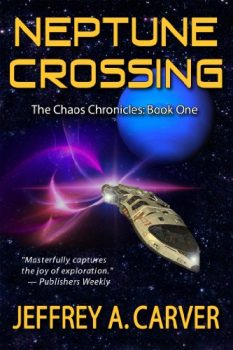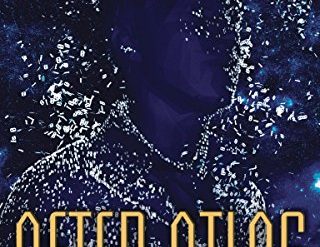
Here’s a series starter that introduces a clever, universe-spanning concept in the context of a novel First Contact story.
About seventy years ago Isaac Asimov published his Foundation Trilogy (which belatedly won the Hugo Award for Best All-Time Series in 1966). Asimov’s conceit was that a far-future “psychohistorian” named Hari Seldon developed a methodology to predict how large populations of people would react under certain predictable circumstances.
A great many years later Jeffrey A. Carver produced the Chaos Chronicles, a series that now consists of six volumes. The books are based on a somewhat similar concept. In Carver’s telling, an alien superintelligence has grasped how to apply chaos theory to anticipate the emergent behavior of large, complex systems. The solar system, for example. And in Neptune Crossing, the first book in the series, a comet is hurtling directly toward Earth. That comet will extinguish all life on the planet—and human scientists are ignorant of the threat. Tragically, only one hapless human pilot stuck in the far-future equivalent of KP duty on Neptune can possibly save the day.
Neptune Crossing (Chaos Chronicles #1) by Jeffrey A. Carver (2010) 582 pages ★★★★☆
Alien intervention takes an unlikely hero on an interplanetary adventure
On a corporate mining survey of Neptune‘s moon Triton late in the twenty-second century, pilot John Bandicut literally stumbles into a pit on the surface. There, he finds himself face to face with an alien artifact—the first-ever evidence of intelligent life of extraterrestrial origin. “He was standing in front of . . . the discovery of the century. An alien machine! It was what the Neptune/Triton explorers had looked for in vain for years.”
Soon it transpires that the device, hidden under Triton’s surface for uncounted millennia, serves as a “translator” for the quarx. It seems that the quarx, an immaterial intelligence, had identified Bandicut as “one who knew the presence of others in his mind, who felt at home with the tidal movement of dataflow and the slow seep of intermingled consciousness.” And now, Bandicut discovers, the quarx has embedded itself in his mind. Even worse, the quarx is intent on guiding him to defy the mining company, betray his friends, steal a spaceship, and fly it directly at enormous speed into that comet threatening life on Earth. Chances are—well, almost certainly—he’ll lose his life in the resulting cataclysmic explosion. And so will the quarx, for that matter. The problem is, Bandicut doesn’t have any choice in the matter.
How far away is Neptune?
So, you pick up this book and you say, sure, let’s take a trip to Neptune. Now, of course you know that Neptune is the most distant planet in the solar system, since Pluto was demoted to dwarf status in 2006. Neptune is located some 2.8 billion miles (4,500 million kilometers) from the sun and more or less that far from Earth, give or take a hundred million miles or so. How long would it take to get there?
Well, assume that a spaceship escapes from Earth at 25,000 miles per hour and continues on its way to the outer solar system. That ship would be on the way for roughly 4,666 days. (That’s almost thirteen years.) Still on board? I doubt it. If you imagine that an interplanetary adventure is in the cards for humanity at any time in the predictable future, you’re probably safe in saying it’s unlikely to start at Neptune.
For further reading
Check out The five best First Contact novels and Good books about space travel, including both nonfiction and fiction.
For more good reading, check out:
- The ultimate guide to the all-time best science fiction novels;
- Six new science fiction authors worth reading now
- Great sci-fi novels reviewed: my top 10 (plus 100 runners-up); and
- The top 10 dystopian novels reviewed here (plus dozens of others).
And you can always find my most popular reviews, and the most recent ones, plus a guide to this whole site, on the Home Page.



























